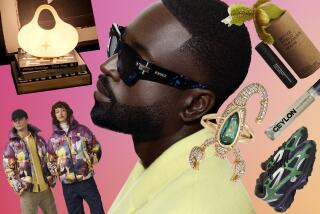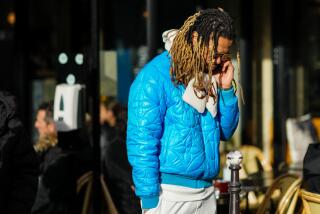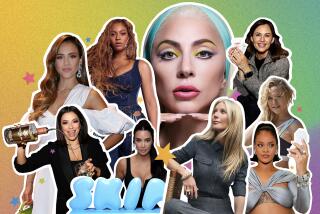Market booms for men’s cosmetics — but don’t call it makeup
Like most guys, Eric Lugo wants to look handsome. But he doesn’t want to be caught applying makeup.
So the 26-year-old uses skin-care products with names like Kiehl’s Facial Fuel and Lab Series’ Power Brightening Serum.
“I want to keep myself up and maintain my looks, but I’d never use anything that looks like it’s made for my girlfriend,” the Los Angeles banker said. “This stuff looks like it’s for guys, not girlie at all, so I feel OK using it.”
Retailers are seeing a booming market in cosmetics and skin care for men. But they face one big challenge — most guys are squeamish about products that seem too feminine.
So skin-care firms have come up with a variety of products with creatively masculine names, packaged in cigar boxes and containers mimicking liquor bottles.
The terminology and instructions are also suitably manly. The colors pink and gold — staples of women’s cosmetics — are out. And the word “makeup” is verboten.
“We don’t say the ‘M’ word. It’s taboo,” said Michele Probst, founder of Menaji, a high-end men’s line carried at Nordstrom.com and department stores.
One popular men’s brand, Jack Black, is sold at places such as Sephora and Bloomingdale’s, and it has a $60 anti-wrinkle lotion called Protein Booster Skin Serum. Estee Lauder’s Lab Series for men sells a $28 eye cream called Eye Balm. And Menaji puts out a $26 concealer called Urban Camouflage and a $35 face powder simply named Anti-Shine.
That smart packaging seems to be doing the trick.
Men’s grooming is one of the fastest growing segments in the beauty business. Chicago-based research firm Mintel forecasts that sales of men’s toiletries will hit $3.2 billion by 2016, up from an estimated $2.6 billion this year and $2.2 billion in 2006.
Companies are eagerly staking territory in this burgeoning market. According to research firm NPD Group, only 1 in 4 guys uses some kind of facial skin-care product, and male shoppers tend to be more brand loyal than women.
Retailers such as Nordstrom andMacy’s are devoting more shelf space to these products, and many are creating separate sections dedicated solely to men.
Cosmetics chain Ulta rolled out in-store boutiques called the Men’s Shop. CVS Pharmacy has created Guy Aisles in its stores devoted to men’s products. Macy’s last week opened a Men’s Grooming Zone in San Francisco with a barber, flat-screen TV, the sports pages and free Wi-Fi.
Nordstrom began shifting its male grooming items out of the beauty department last fall and into the men’s furnishings area, staffed by a trained salesclerk ready to guide confused men, said Jennifer Kovacs, Nordstrom’s national merchandise manager for fragrances.
“Men are just more comfortable in their own environment, away from makeup and pink,” Kovacs said, adding that male grooming is “a really strong and growing category for us.”
Skin-care brand Kiehl’s is building Shave Bars inside its stores decked out with black subway tiles and displays that resemble gym lockers. Kiehl’s President Chris Salgardo said the company realized the potential of male shoppers during the worst days of the Great Recession, when men’s grooming grew while other categories declined across the board,
The popularity of men’s grooming is driven by baby boomers eager for an edge in the workplace and younger fellows influenced by changing standards of male beauty. It’s not just deodorant and after-shave — these guys are reaching for powders, concealers, anti-aging creams and tinted moisturizers.
“It’s become more socially acceptable for men to put effort into looking and feeling good,” said Damon Jones, a spokesman at Proctor & Gamble, whose brands include the Art of Shaving and Gillette. “The whole metrosexual trend has gone more mainstream.”
Although men across all demographics are dabbling, those under 35 and over 50 are diving most enthusiastically into grooming products, said Karen Grant, a beauty analyst at NPD Group.
“Mature men are trying to be competitive in the workplace, and for those who are online dating, there is a desire to be as vibrant looking as possible,” Grant said. “The younger generation has grown up with Mom slathering sunblock on their face, so they are coming up aware of facial skin care.”
Companies angling to attract the average Joe are squeezing in as many masculine come-ons and buzzwords as possible.
Menaji packages items into recycled cigar boxes and bottles purposely crafted to look innocuous with a simple black-and-burnt orange color scheme. The Urban Camouflage concealer, for example, looks like a ChapStick.
“Regular guys can carry the concealer into business meetings, go to the bathroom to touch up and no one can tell the difference,” Probst said. Sales have doubled in the last five years.
Emily Dalton and Curran Dandurand, founders of the Jack Black brand, designed the line’s bright blue containers to evoke motor oil cans and liquor bottles. Along with choosing “manly” names such as Turbo Wash and Beard Lube, the company is pushing products intended to ooze masculine appeal, Dalton said.
The same idea went into picking the brand’s name, which has no relation to the actor, she said. “Jack Black sounded like the quintessential guy’s guy kind of name. It’s the kind of name that guys would feel comfortable telling their buddies about — it doesn’t feel feminine or fussy.”
Since most guys don’t like to browse the way women do, some companies are going where the men are. Jack Black, for instance, gives out samples and free facial treatments in stadiums at sports games, including several times at Dallas Cowboy games.
Unilever brands, which include Dove, Vaseline and Axe, have increased advertising on the Web, especially on popular online videos, where men spend twice as much time as women, said Rob Candelino, Unilever’s vice president of brand building.
“We used to talk to guys through the women, who were the gatekeepers — whatever she bought he would consume,” Candelino said. “But now 50% of guys are the primary shoppers in their household.”
Marquez Briggs, a 30-year-old music producer, first got into skin care five years ago after trying his wife’s products in the shower. Now he’s hooked. Briggs frequently tries out new creams and washes and regularly stocks up on Neutrogena concealer for his face.
“I’m in the music industry, so it’s important that I look good,” the Los Angeles resident said. “I’ll tell friends and some will say ‘That’s for a girl,’ and a few years later I’ll find that they are using it too.”
But companies acknowledge that marketing to men can be tricky.
Kiehl’s is testing formulas for tinted moisturizer, which is “the next horizon for men,” said Salgardo, the company’s president. But it is treading cautiously.
“If they grab a tube and squeeze out anything resembling makeup, they would run for the hills,” he said. “It’s a slippery slope for guys.”
More to Read
Sign up for our L.A. Times Plants newsletter
At the start of each month, get a roundup of upcoming plant-related activities and events in Southern California, along with links to tips and articles you may have missed.
You may occasionally receive promotional content from the Los Angeles Times.







